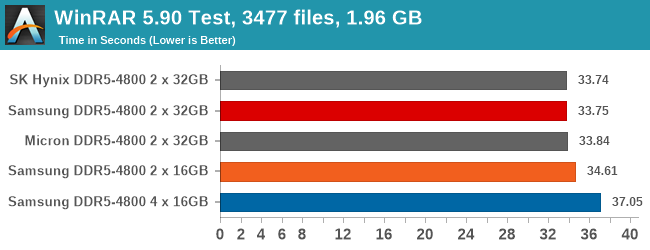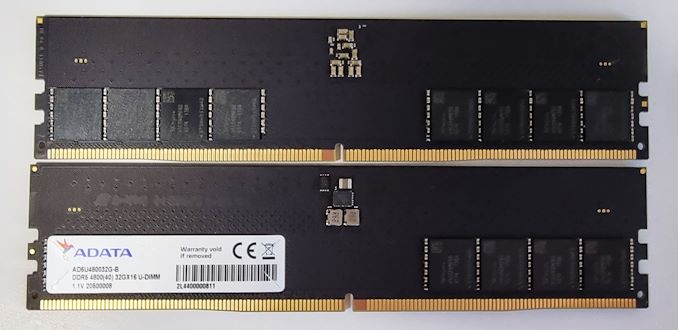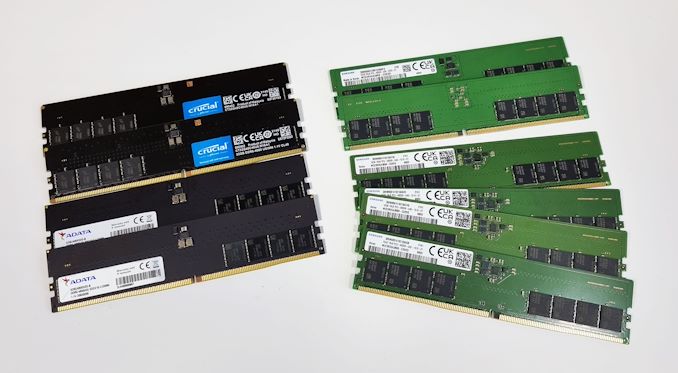DDR5 Demystified - Feat. Samsung DDR5-4800: A Look at Ranks, DPCs, and Do Manufacturers Matter?
by Gavin Bonshor on April 7, 2022 8:00 AM EST- Posted in
- Memory
- Intel
- Samsung
- Micron
- SK Hynix
- DDR5
- Alder Lake
- DDR5-4800
- 12th Gen Core
- Z690
Conclusion
When selecting a memory kit for a new system, the market is littered with many choices ranging in speed, heatsink design, RGB or no RGB, and capacity. In terms of DDR5 memory, the only platform that can utilize this at the moment is Intel's 12th Gen Core series, with its premier offerings coming in conjunction with the Z690 chipset. This is likely to change later on this year if AMD's Zen 4 architecture launches, but right now, the DDR5 market and the Alder Lake market are one in the same.
For today's article, we focused at looking at the performance differences (or lack thereof) in DDR5 in different rank and DIMM per channel configurations. While these elements are smaller factors in DDR5 performance than frequency and clockspeed, as we have found, they do have a meaningful impact on memory subsystem performance – and thus an impact on overall system performance.
Samsung DDR5-4800B: 1Rx8 (1DPC/2DPC) versus 2Rx8 (1DPC)
In testing Samsung's 2 x 32 GB (2Rx8) kit directly against a 4 x 16 GB (1Rx8) kit, we got some interesting results running at JEDEC speeds with Intel's Core i9-12900K processor.

Looking at situations where the differences were evident in benchmark results, in our WinRAR 5.90 test, which is very sensitive to memory performance and throughput, the Samsung DDR5-4800 4 x 16 GB kit performed around 9% worse than its higher density 2 x 32 GB counterpart, which is quite a drop. And even in a 1DPC configuration, the 2 x 16 GB kit with its single rank of memory does operate at a deficit versus the dual rank kits. This indicates that using 1DPC yields better performance in memory-sensitive applications than 2DPC. Meanwhile, the Samsung DDR5-4800B 2 x 32 GB configuration performed within a solid margin of error against SK Hynix and Micron kits.

It was much the same in some of our game testing, with the Samsung 4 x 16 GB kit being outperformed by the 2 x 32 GB kits, and even the Samsung 2 x 16 GB kit, which is the same single-rank UDIMMs as the 4 x 16 GB combination. While the performance hit was only around 2-3% in Grand Theft Auto V at 4K low settings, in our testing and from a performance point of view, Intel's Alder Lake seems to perform better with two sticks against four sticks of memory.
Throughout most of our testing, it was clear that in most situations, having two higher density 2Rx8 sticks in a 1DPC configuration versus the same capacity in 4 sticks (1Rx8 at 2DPC) is better for overall performance. And even looking at just 1DPC configurations, going dual-rank is still better, though to a smaller degree.
Going under the hood for an explaination for these results, the main reason that 2Rx8 is better than 1Rx8 comes down to how the integrated memory controller can only access one level of rank at a time. So in a dual rank DIMM, Rank Interleaving can be employed, which allows the second rank of memory chips to be ready for immediate access. While the differences are minimal even on a theoretical basis, as we have seen they are not zero: rank interleaving reduces response times in the pipeline refresh cycles, which can mean more performance in latency-sensitive applications, or when an application is going to be able to push DDR5 to its overall bandwidth limits.
Samsung vs SK Hynix vs Micron 32GB DDR5-4800B
Looking at the performance of the 2 x 32 GB kits running at DDR5-4800B from Samsung, SK Hynix, and Micron, the difference was for all practical purposes non-existent. We did not find any meaningful performance difference in our testing, which means that performance isn't a differentiating factor between the three memory manufacturers – at least at JEDEC settings with Alder Lake. Which, given the identical timings and capacities, is not unexpected. This is essentially the null hypothesis of our testing, showcasing that at least from a performance standpoint at fully qualified clockspeeds, there's no innate performance difference from one DRAM manufacturer to another.
Consequently, it's pretty easy here to recommend that if users are planning to build an Intel 12th Gen Core series setup with JEDEC-rated DD5 memory, they should opt for the cheapest option among proven DIMM vendors. For desktop purposes, the DIMMs are functionally equal, and right now DDR5 memory itself is still rather expensive. Although there's much more choice available in stock than there was last year, and it's still a relatively new platform, so that also adds to the cost.
Final Thoughts: 64GB of 2Rx8 with 1DPC is Better Than 64 GB of 1Rx8 with 2DPC
One of the biggest things to note from this article is that there isn't really any difference in performance between Samsung, SK Hynix, or Micron-based 2 x 32 GB DDR5-4800B memory kits. Despite using different memory ICs from each of the vendors, all these kits show that 2Rx8 DDR5 memory performs better than 1Rx8 DDR5.
The only aspect we didn't test was overclocking headroom with the JEDEC-rated kits, which wasn't really an angle we wanted base an article around. Given the lottery-like results of overclocking on any given DIMM, we'd be testing our own luck more than we'd be testing the hardware. In these cases a large sample size is required to get useful data, and that's where the dedicated memory vendors come in with their binning processes.
Taking a more meta overview on the state of the DDR5 market, we already know from vendors such as ADATA, G.Skill, and TeamGroup, that Samsung and SK Hynix's current generation parts show greater frequency and latency headroom when running above DDR5's nominal voltage of 1.1v. Which is why DDR5-6000 (and beyond) kits aren't using Micron chips. Though this may change in the future as all three companies are looking to the future with its manufacturing process, including EUV lithography.

2 x 32 GB kits of DDR5-4800B memory outperform 4 x 16 GB kits at the same frequency/latencies
As for the matter of today's tests, our results are very clear: dual-rank memory is the way to go, as is sticking to a single DIMM per channel when possible.
The most significant performance differences in our testing are found comparing two of Samsung's 1Rx8 DDR5-4800B memory sticks in a 1DPC configuration against four of the same sticks in a 2DPC configuration. There we find that the 1DPC configuration is contently equal or better in every scenario. Using four sticks means data has to travel further along the memory traces, which combined with the overhead of communicating with two DIMMs, results in both a drop in memory performance as well as a sight increase in latency.
And while the differences between 1Rx8 and 2Rx8 are not as large, we find that there is still a difference, and it's in favor of the dual rank memory. Thanks to rank interleaving, single rank memory finds itself at a slight disadvantage versus dual rank memory, at least on today's Alder Lake systems.
Based on this data, we recommend that users looking for 64 GB of DDR5 memory opt for 2 x 32 GB, rather than using a 4 x 16 GB configuration. Besides providing the best performance, the 2 x 32 GB route also leaves room for users to add additional capacity as needed down the line. Plus, if users want to overclock them further, overclocking four sticks of memory is notoriously stressful for the processor's IMC – and DDR5 only makes this worse.
Otherwise, choosing between DDR5-4800B kits from Micron, SK Hynix, and Samsung in terms of 2 x 32 GB kits primarily comes comes down to availability and price. DRAM is a true commodity product, in every sense of the word, so for these JEDEC-standard kits, there's not much to compete on except pricing.











66 Comments
View All Comments
DanNeely - Thursday, April 7, 2022 - link
Only 16Gb of ram will be dual channel, the top 24GB will be single channel and half as fast. If it prevents having to swap you'll still see a benefit; but if you need - or think you'll need - more than 16gb of ram at some point during the laptops lifespan you should avoid any models with 8gb soldiered.Ryan Smith - Thursday, April 7, 2022 - link
We don't have any laptops like that in house right now. But I'll make note of that for once we get a DDR5 laptop in with such a configuration.zforgetaboutit - Thursday, April 7, 2022 - link
Benchmark Speedometer 2.0 - suspicious scores seenWhen I ran it (from your link) 3 times, my overall score was 170+ each time, which is 11% better than your best score. How can this be? Please advise.
my sample run
---------------
Detailed Results
Iteration 1 168.7 runs/min
Iteration 2 152.0 runs/min
Iteration 3 177.1 runs/min
Iteration 4 173.5 runs/min
Iteration 5 173.3 runs/min
Iteration 6 179.7 runs/min
Iteration 7 166.4 runs/min
Iteration 8 163.4 runs/min
Iteration 9 178.6 runs/min
Iteration 10 176.0 runs/min
Arithmetic Mean:171 ± 6.1 (3.6%)
---------------------------------------------------------------------
I have middle-of-the-road 4 x 8GB DDR4-2133 @ ~1440 GHz, running on an Intel i7-6700k, as follows
CPU-Z TXT Report
-------------------------------------------------------------------------
CPU-Z version 1.99.0
...
Memory SPD
-------------------------------------------------------------------------
DIMM # 1
SMBus address 0x50
Memory type DDR4
Module format UDIMM
Module Manufacturer(ID) Corsair (7F7F9E0000000000000000000000)
SDRAM Manufacturer (ID) SK Hynix (AD00000000000000000000000000)
Size 8192 MBytes
Max bandwidth DDR4-2133 (1066 MHz)
Part number CMK32GX4M4A2666C16
Nominal Voltage 1.20 Volts
EPP no
XMP yes, rev. 2.0
AMP no
DIMM # 2
SMBus address 0x51
Memory type DDR4
Module format UDIMM
Module Manufacturer(ID) Corsair (7F7F9E0000000000000000000000)
SDRAM Manufacturer (ID) SK Hynix (AD00000000000000000000000000)
Size 8192 MBytes
Max bandwidth DDR4-2133 (1066 MHz)
Part number CMK32GX4M4A2666C16
Nominal Voltage 1.20 Volts
EPP no
XMP yes, rev. 2.0
AMP no
DIMM # 3
SMBus address 0x52
Memory type DDR4
Module format UDIMM
Module Manufacturer(ID) Corsair (7F7F9E0000000000000000000000)
SDRAM Manufacturer (ID) SK Hynix (AD00000000000000000000000000)
Size 8192 MBytes
Max bandwidth DDR4-2133 (1066 MHz)
Part number CMK32GX4M4A2666C16
Nominal Voltage 1.20 Volts
EPP no
XMP yes, rev. 2.0
AMP no
DIMM # 4
SMBus address 0x53
Memory type DDR4
Module format UDIMM
Module Manufacturer(ID) Corsair (7F7F9E0000000000000000000000)
SDRAM Manufacturer (ID) SK Hynix (AD00000000000000000000000000)
Size 8192 MBytes
Max bandwidth DDR4-2133 (1066 MHz)
Part number CMK32GX4M4A2666C16
Nominal Voltage 1.20 Volts
EPP no
XMP yes, rev. 2.0
AMP no
zforgetaboutit - Thursday, April 7, 2022 - link
I'm running Win10 (latest), Chrome v100.0 .Ryan Smith - Thursday, April 7, 2022 - link
"I'm running [...] Chrome v100.0 ."That's likely why. We're locked to an fixed (older) version of Chrome in order to prevent software updates from breaking the apples-to-apples nature of our testing.
zforgetaboutit - Thursday, April 7, 2022 - link
I see your point.Then there's also a possibility Chrome may have improved by 10% since your version.
DanNeely - Thursday, April 7, 2022 - link
Chrome improving, or getting worse, from one version to the next is Ryan's point.zforgetaboutit - Thursday, April 7, 2022 - link
That's his point that I saw.repoman27 - Thursday, April 7, 2022 - link
Intel also distinguishes between systems with 1 or 2 DIMM slots routed per channel. The supported timings for the various configurations as listed in the Alder Lake datasheets are:1DPC (1 DIMM slot routed per channel):
DDR5-4800 40-40-40 2N
2DPC (2 DIMM slots routed per channel):
1DPC populated = DDR5-4400 40-37-37 2N
2DPC populated 1R/1R = DDR5-4000 36-34-34 2N
2DPC populated 2R/2R = DDR5-3600 (timings not specified)
So it should be noted that all of these tests were conducted with the memory controller in an overclocked condition. And although you state that all tests were performed at default settings as per firmware, you don't specify what frequencies and timings were actually used.
I also find it somewhat frustrating that these kinds of tests always highlight the performance difference between 1DPC and 2DPC configurations without showing the corresponding performance delta for situations where you are memory capacity constrained. Even with the fastest SSDs, the penalty for constant swapping to disk is way worse than running 2DPC.
And 8 GB DDR5 modules using x16 DRAMs are also a thing.
eldakka - Wednesday, April 13, 2022 - link
Mostly Valid points.However, the point regarding (physical) memory exhaustion and hitting swap hard is not much of a concern when we are focused on consumer - especially gaming consumer - systems when we are talking using a minimum of 32GB (2x16GB) RAM. This is why all reputable recommendations on gaming systems recommend a 16GB RAM (more is good, but generally unnecessary for a gaming-focused rig, less is not good), to avoid that sort of swapping. And the 32GB minimum RAM benchmark used here is twice that recommendation.
Concerns of RAM exhaustion at 32GB is misplaced when taken in the context of the target audience for this benchmarking.
It is, of course, a concern for more professional workloads or more niche situations, such as someone leaving a bazillion browser windows open, playing back a streaming movie or sports event on the 2nd monitor, citrixed into work, and playing a game at the same time (raises hand). However, as this isn't the focus of this article, not benchmarking those situations is not an unreasonable decision.
If you need those more professional-oriented benchmarks, then await a separate article that may cover that, or perhaps visist a more professional-workload-focused publication.